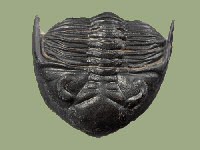|
|
|
TRILOBITA::
Homepage:: Trace fossils:: Preparation:: Cabinet:: Literature:: Links:: Geological Time:: Special:: Explanations::
The Team :-)
Comments:: The Arthropoda:: Exoskeleton:: The Cephalon:: Trilobites eyes:: Limbs:: Enrollment:: Habitats::
Trilobite Orders::
|
Life below Oceans Surface- The Habitats - |
|
For worlds famous gill breathers there are three hip around- kinds of hanging about their marine medium: drifting around, swimming around and crawling around ;-))) According to this, Trilobites biotic communities are to be shown as following:
So this can be assumed, representatives of the Order Agnostida led a planktonic mode of life, i. e. floating with drift (passive) inside the plankton. One biotic indices concerning this mode of life is the wide global distribution of a big number of fossil Agnostides within a very short- time geological period. Amongst the active natant trilobites (nekton), according to the body shapes (elongate, streamlined body shapes in opposite to broad shapes) there must have been trilobites with more or less good swimming abilities. Aside from body structures pelagic living trilobites are to be distinguished from their benthic relatives with the eyes. Swimmers of the pelagic water column had big eyes relative to cephalons size, with lenses arrayed the patterns (quantity and adjustment), guaranting nearly an all-round sight. On the other hand the eyes of trilobites moving through a benthic layer were designed for a primary upwards- (e.g. detection of predators) and lateral visual field. With regard to their feeding habits, trilobites are comparable to their recent relatives, the Crustacea. According to this, they are classified to predators, filter feeders and particle feeders (endogeic). Predators typically possessed spines (sometimes even fang- like) at their upper ventral appendages (gnathobase to fix the prey, or transporting the prey forward by using the gnathobases of the anterior limbs, and finally slashing the prey by their special distincted Hypostoma. Another arbitrary indication for a predatory way of life was a great inflated Glabella, housing an appropriately big stomach for initial processing of large chunks of prey. Filter feeders shared a big vaulted cephalon considerably developed more convex in opposite to the remaining body. Below this cephalon there was a cavern, filling it with sediment by the use of anterior spine, rows of pits or by paddling with the legs. By use of a respective species- specific designed "filter- system" the nutritious contents were seperated from "waste" and ingested. As a rule endogeic trilobites had many thoragic segments (appropriate number of pairs of legs for rooting), a relatively small glabella and a 'flexible' hypostome (natant condition) for strongly digging up the sediment.
|
|
|
|
|
|
|
|
|
|
|



